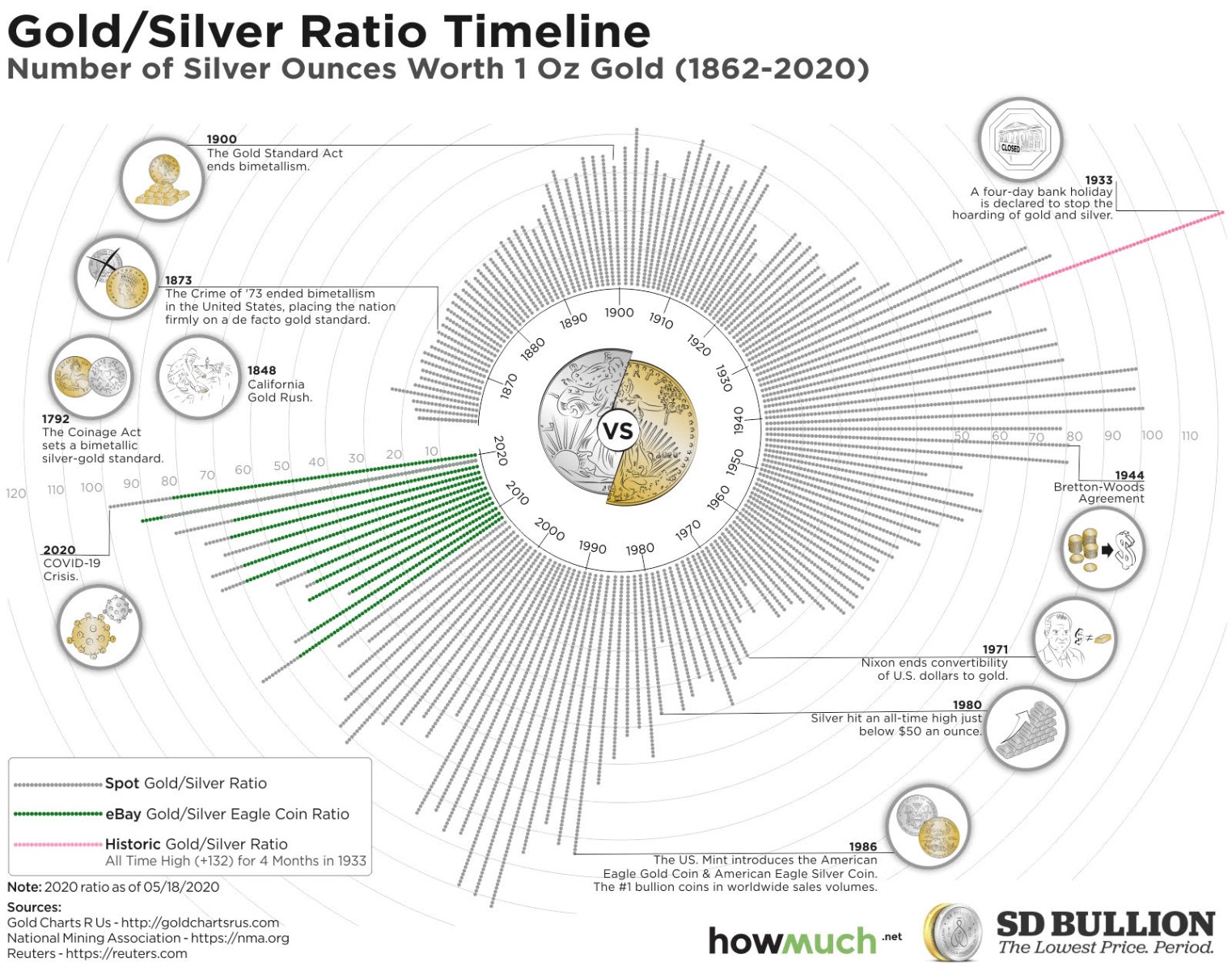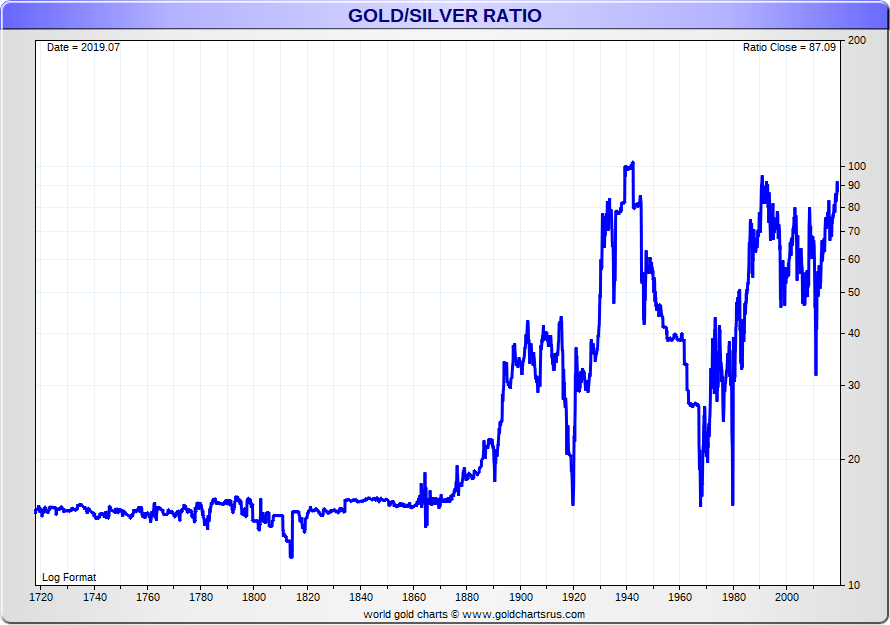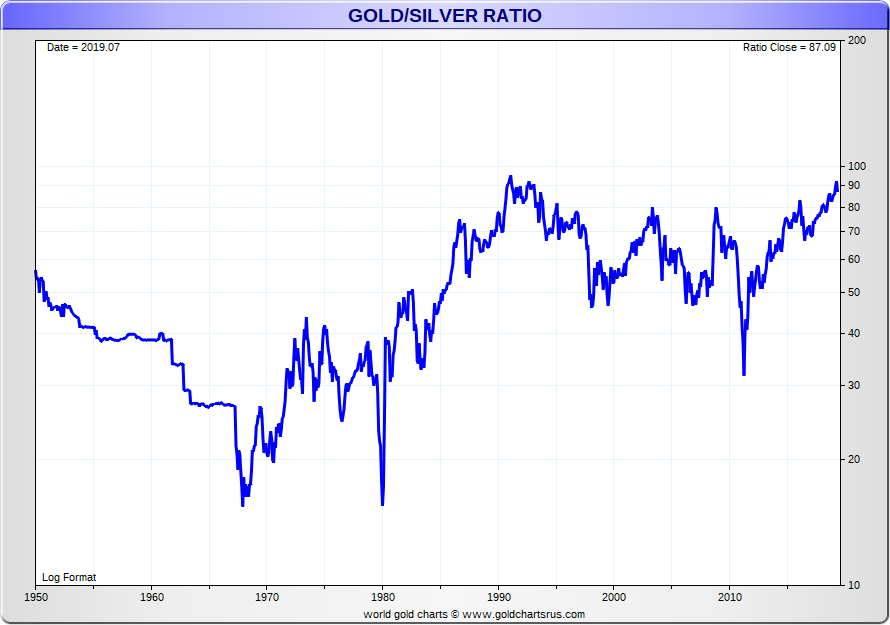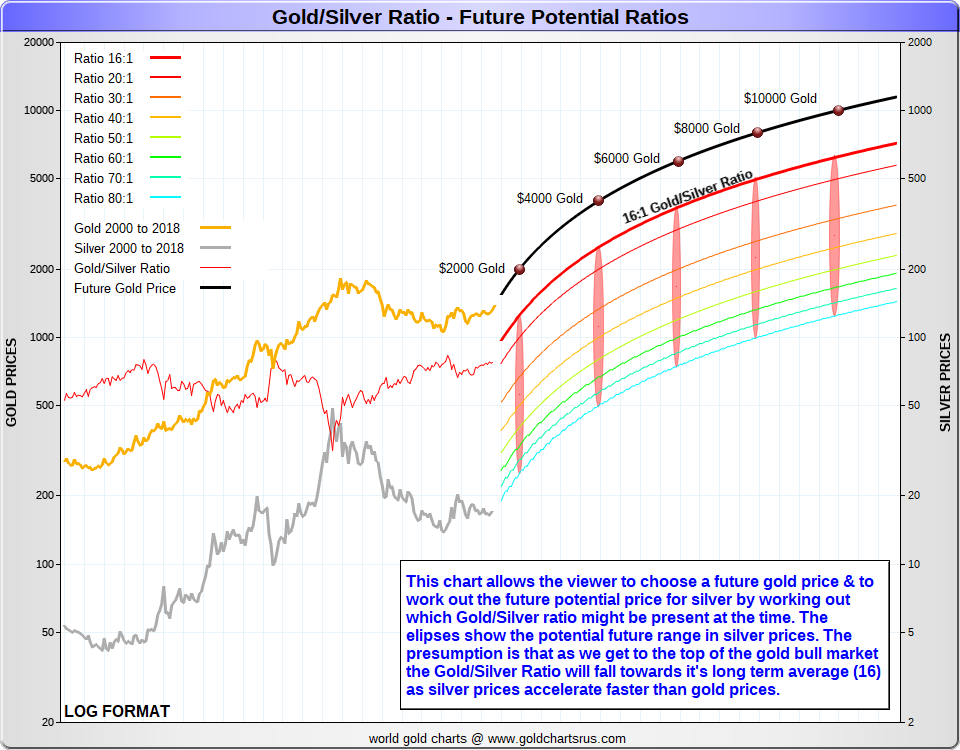Gold Silver Ratio
Live Gold Silver Ratio Charts, Historical Gold vs Silver
The Gold Silver Ratio is by far the most watched relative ratio measurement in precious metals investing. Scroll down to see the live Gold Silver Ratio as well as longterm charts of Gold Silver Ratio history.
What is the Gold-to-Silver Ratio?
The gold-to-silver ratio measures how many troy ounces of silver are needed to purchase one ounce of gold.
What Does it Indicate?
A high ratio means silver is relatively undervalued compared to gold. A low ratio means gold is relatively undervalued compared to silver.
How to Calculate Gold-to-Silver Ratio:
It’s calculated by dividing the current price of gold by the current price of silver.
- Find the current price of 1 troy ounce of gold.
- Find the current price of 1 troy ounce of silver.
- Divide the gold price by the silver price.
Top Selling Bullion Products


Share our original content for free using these guidelines:
– Please link back to the original source here
– Please provide attribution to “SD Bullion”
Live Gold Silver Ratio Charts, Historical Gold vs Silver
The Gold-Silver Ratio is one of the most closely followed measures in the precious metals market, tracking how the metal prices of gold and silver move in relation to each other. This ratio shifts as market trends and conditions in the broader financial markets influence price movement. By exploring historical data and ratio history, you can see how the relationship between gold and silver has changed over time. Scroll down for live updates, long-term ratio charts, and chart analysis to better understand the story behind these two metals.
Let us begin this analysis with a clear explanation of what the Gold-Silver Ratio is.
Gold Silver Ratio - (n) the dynamic moving amount of silver one can theoretically buy with a fixed amount of gold. Typically, in the Western world, the gold-to-silver ratio is measured in the number of troy ounces of silver one can acquire with one troy ounce of physical gold. Although it can also be estimated in equivalent sizes of bullion weights: grams, kilos, tonnes, etc.
Many modern-day gold and silver bullion buyers and traders use the fluctuating Gold Silver Ratio to determine which precious metal may be poised to outperform the other.
For example, we will examine times the Gold-Silver Ratio has fallen above or below its 20th and 21st Century averages, or longer, which will show you in various longer-term Gold-Silver Ratio charts below.
Depending on their outlook, time horizons, and beliefs, physical precious metal savers may want to buy more gold or more silver, depending on whichever may appear to be more undervalued to the other.
Regarding geologists, we find roughly 8 parts of silver to 1 part gold in the ground. Silver and gold's historic monetary ratio has typically averaged around 16, and has little, if anything, to do with how they are valued today. Remember that silver has been divorced from the modern financial system since 1964
Only produced by star explosions, the lack of a precious supply of both physical silver and gold bullion is one significant attribute to its enduring value. There are, of course, many trillions of other reasons the world saves silver and gold for wealth preservation and even appreciation at the right timeframes.
Extreme privacy between the two bullion types is just one additional attribute they both share.
Gold Silver Ratio Volatility
The Gold-Silver Ratio has shifted dramatically across different places and eras, serving as a long-standing technical indicator in the history of bullion investing. Even in ancient times, it influenced trade, asset allocation, and economic policy. For example, the Roman Empire officially fixed the ratio at 12:1, while centuries later the U.S. government set it at 15:1 under the Coinage Act of 1792.
Today, you can view the modern Gold-Silver Ratio and related spot prices using our interactive chart above—an essential tool for market analysis and any investing guide that covers precious metals. This ratio offers perspective on how gold and silver prices move relative to each other, helping new buyers understand long-term ratio history and short-term price movement.
In past bull markets, gold often leads in the early stages, acting as an inflation hedge and store of value during times of economic uncertainty. Silver historically catches up later, sometimes outperforming gold during speculative surges when more participants—both everyday buyers and high net worth investors—shift toward silver bullion in their investment strategy.
Industrial demand also shapes silver’s spot prices. Its role in electronics, solar technology, and other industries can contribute to significant price movement, especially during periods of high production or global economic growth. Gold, in contrast, is used more as a security asset and inflation hedge, often benefiting from shifts in monetary policy or rising concern over currency stability.
Historical examples, such as the bull markets of 1980 and 2011, show how both metals can respond to broader market forces. While some attribute silver’s 1980 spike to speculative buying, a broader market analysis reveals that nearly all commodities rose sharply during the 1970s due to economic uncertainty and monetary shifts.
When silver’s performance outpaces gold—especially during periods of fiat currency skepticism—it often reflects a wider market sentiment questioning the long-term value of paper money. In such cycles, the Gold-Silver Ratio can act as a technical indicator of shifting demand and potential price corrections in the precious metals market.
Over the centuries, the ratio has been influenced by government controls, central bank actions, and commodity market mechanisms such as futures contract trading. It has ranged from as low as 2.5 ounces of silver for 1 ounce of gold in ancient Egypt, to over 100 ounces in the 1930s during forced U.S. gold confiscations. Understanding this history offers valuable insight for portfolio diversification and bullion investing strategies today, as part of a broader approach to asset allocation and gold forecast analysis.
The following chart covers the past 300 years of the Gold-Silver Ratio.
Gold Silver Ratio 300-Year Chart

What happened with the Gold-Silver Ratio following the US Civil War?
What happened with the Gold-Silver Ratio following the confiscation of US citizens' private Gold and Silver (1933 / 1934)?
Gold Silver Ratio 70 Year Chart

What caused the lows in the Gold-Silver Ratio in the years leading into 1968, in early 1980, beginning in 2010 and into the year 2011 respectively?
Here at SD Bullion, you can learn more about the fundamental investment factors for gold and silver investing.
Given the way both the silver spot price and gold spot price are mainly discovered by dominating synthetic derivatives at this moment in time, it is not until lessening supplies vs. increased demand factors exacerbate that we often historically see the Gold Silver Ratio drop sharply.
The last significant example of this was from 2009 to the 2011 timeframe, in which physical bullion buying at the margin forced the Gold Silver Ratio sharply downwards, reaching levels as low as 32 or 3,3, depending on the derivatives one uses to measure by.
Of course, one doesn't have to look far to find what may sound like ridiculous gold price predictions. Often, many are arithmetically based on historical US dollar monetary base outstanding precedent. Every 50 years or so, the outstanding US dollar issuance is accounted for by the official US gold reserves. We believe we are on track for another historic beating of the nation's fiat currency, i.e, the US dollar, by gold in the 2020s.
If, for example, the spot price of gold were to hit $5,000 oz USD and the Gold-Silver Ratio tightened to its multi-millennia and naturally occurring near the ground averages, the world could simultaneously have silver spot prices well above $100 oz USD.
The following logarithmic format chart has possible projections for future Gold Silver Ratios moving into the 2020s.
The yellow line tracks the ongoing fiat US dollar price of gold in this 21st-century bullion bull market (see left axis).
The red line tracks the ongoing Gold Silver Ratio in this 21st Century bullion bull market (see right axis, used for both the continuing ratio and the US dollar silver price).
The gray-colored line tracks the ongoing fiat US dollar price of silver in this 21st-century bullion bull market (again see the right axis).
The following logarithmic format chart has possible projections for future Gold Silver Ratio potentials moving into the 2020s.
Gold Silver Ratio Potential Future Chart

A logarithmic chart like the one above is a nonlinear way of showing data, often used when tracking a wide range of values; this makes it perfect for visualizing the potential price ratio levels of gold and silver. In this type of chart, the same vertical distance represents the same percentage change, whether it’s silver moving from $50 to $100 per ounce or from $100 to $200 per ounce; both represent a 100% increase, and the chart spacing makes them easy to compare at a glance.
Many buyers of physical bullion, including gold coins, silver coins, and bullion bars, watch this ratio as part of their market perspective. While the future is never certain, some view the long-term silver outlook and historical patterns as reasons to track where the ratio might move over the coming decades; this type of market analysis can be especially interesting for those exploring whether to buy silver or buy gold as part of a broader bullion collection.
You can also explore the full 5,000-year history of the Gold-Silver Ratio to see how it has shifted over centuries. Before the industrial revolution made large-scale silver mining more practical, often as a by-product of other metals, the ratio was far lower than in modern times.
For more background, we have created an educational guide covering the Gold-Silver Ratio and how some precious metals enthusiasts use it when purchasing physical bullion, whether in the form of gold coins, silver coins, or bullion bars.
How is the ratio calculated?
The gold-silver ratio is calculated by dividing the current gold price by the current silver price. For example, if gold is $2,000 per ounce and silver is $25 per ounce, the ratio is 80. This means it takes 80 ounces of silver to equal the value of one ounce of gold, a useful metric for evaluating silver investments and the silver market overall.Why does the gold-silver ratio matter to investors and traders?
The ratio helps investors and those trading precious metals assess relative value. A high ratio may signal silver is undervalued, encouraging investors to purchase silver. A low ratio may suggest gold is the better buy. This tool assists in timing decisions to buy gold or silver and helps manage risk within a diversified portfolio that may also include assets like stocks.What does a high ratio historically signal?
A high gold-silver ratio often signals that silver is cheap compared to gold. Historically, this has preceded periods when silver investments tend to outperform gold in terms of percentage gains. According to historical data, such trends can attract traders looking to take advantage of silver’s upside potential within the broader silver market.
What does a low ratio historically signal?
A low gold-silver ratio typically suggests gold is undervalued compared to silver. In this scenario, silver may have appreciated significantly due to industrial applications or investor demand, making it more expensive compared to one ounce of gold. Investors might see this as an opportunity to buy gold as a more affordable hedge.
Does the ratio predict future prices?
Not directly. While the gold-silver ratio reflects relative pricing, it doesn’t predict specific future prices for either metal. Investors should consider it alongside other tools—like historical data, trends in the current silver price, and broader economic indicators—when evaluating precious metals and silver investments.
How often is the chart updated on this page?
The gold-silver ratio chart is updated on a daily basis using the most recent spot prices for both metals. This ensures you get a timely and fairly steady snapshot of how one ounce of gold compares in value to a single ounce of silver in the current silver market.
How often is the chart updated on this page?
The gold-silver ratio chart is updated on a daily basis using the most recent spot prices for both metals. This ensures you get a timely and fairly steady snapshot of how one ounce of gold compares in value to a single ounce of silver in the current silver market.
What macro factors move the gold-silver ratio?
The ratio is influenced by a range of macroeconomic forces, including inflation expectations, interest rates, and global economic risk. Demand for silver’s industrial applications, along with central banks and governments seeking monetary stability, also play a role. Investor sentiment toward safe-haven assets like gold and silver further affects the ratio.
Are there limits to relying on the gold-silver ratio?
Yes. The ratio doesn’t fully reflect differences in supply and demand or the industrial applications that heavily influence the current silver price. While it's a useful trading tool, it shouldn’t replace a broader investment strategy that accounts for market trends, silver investments, and the purchase behavior of metals alongside other assets like stocks.







